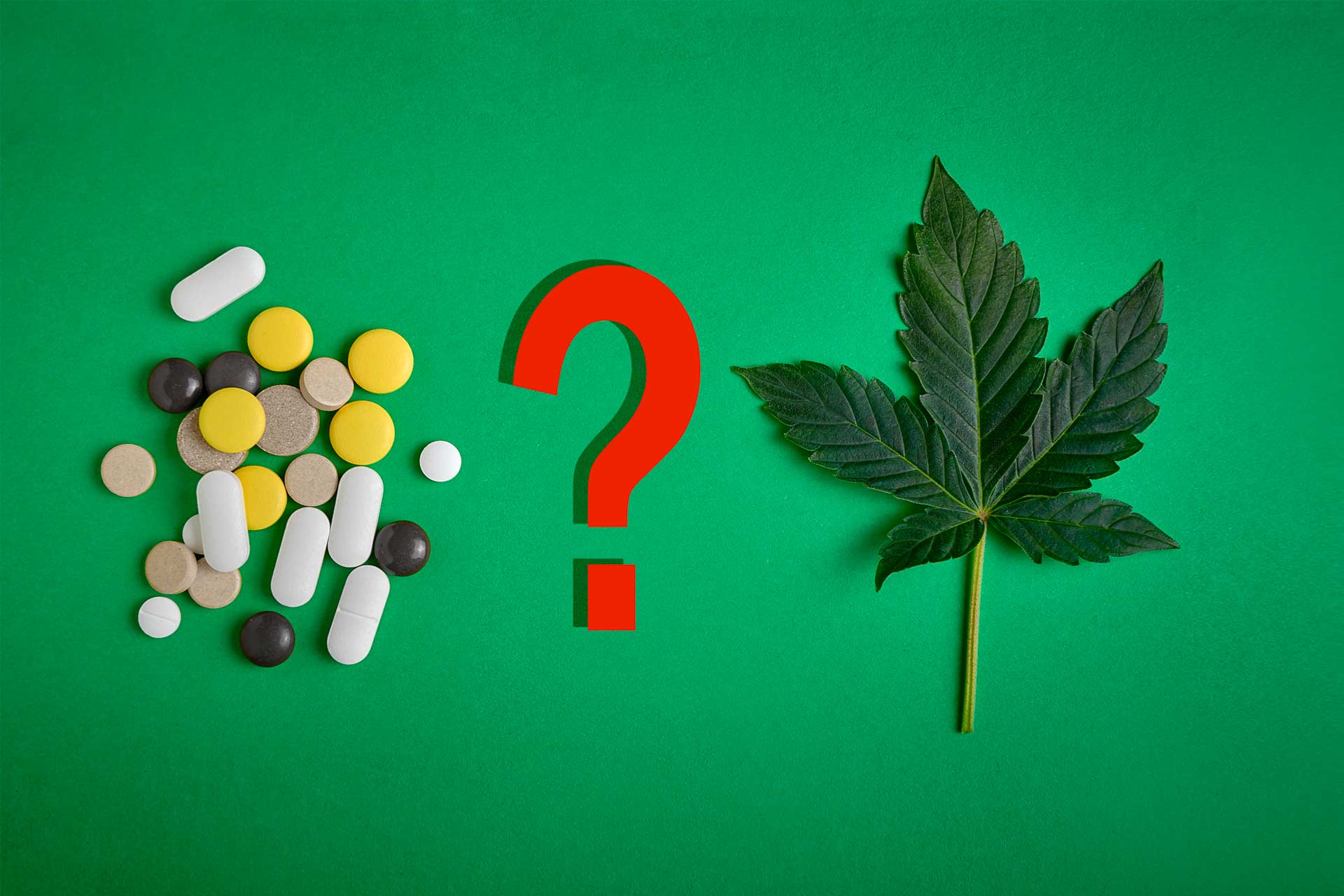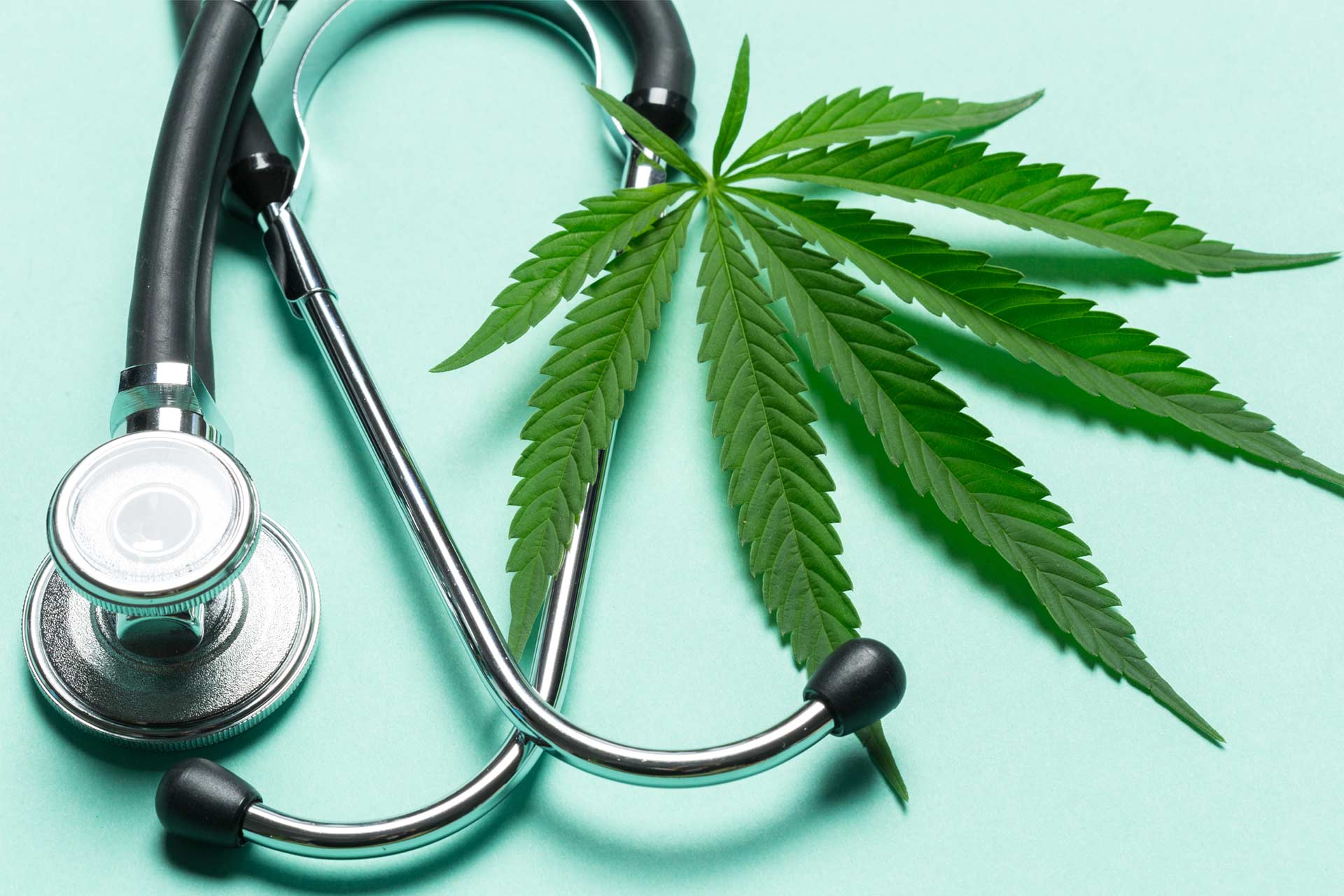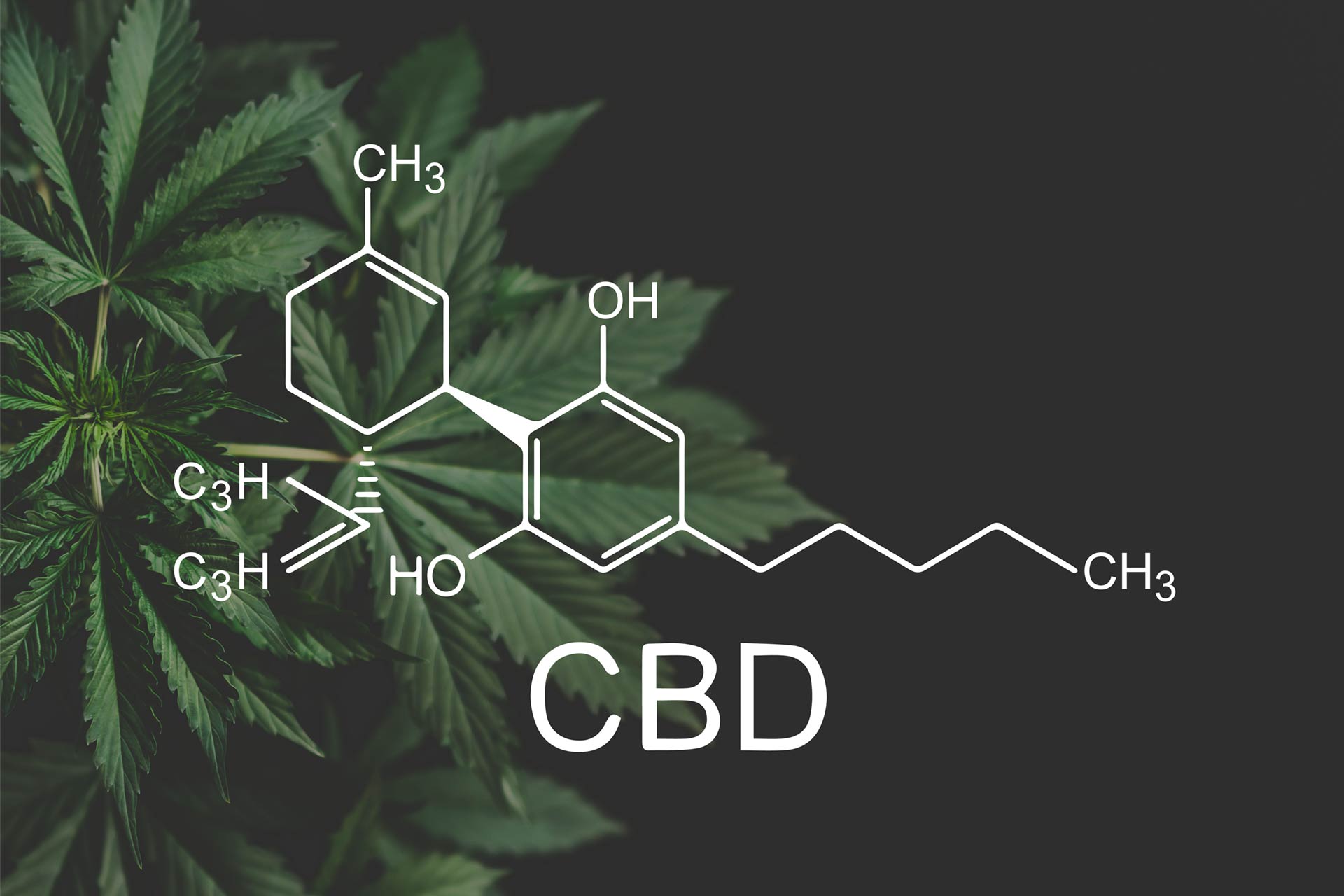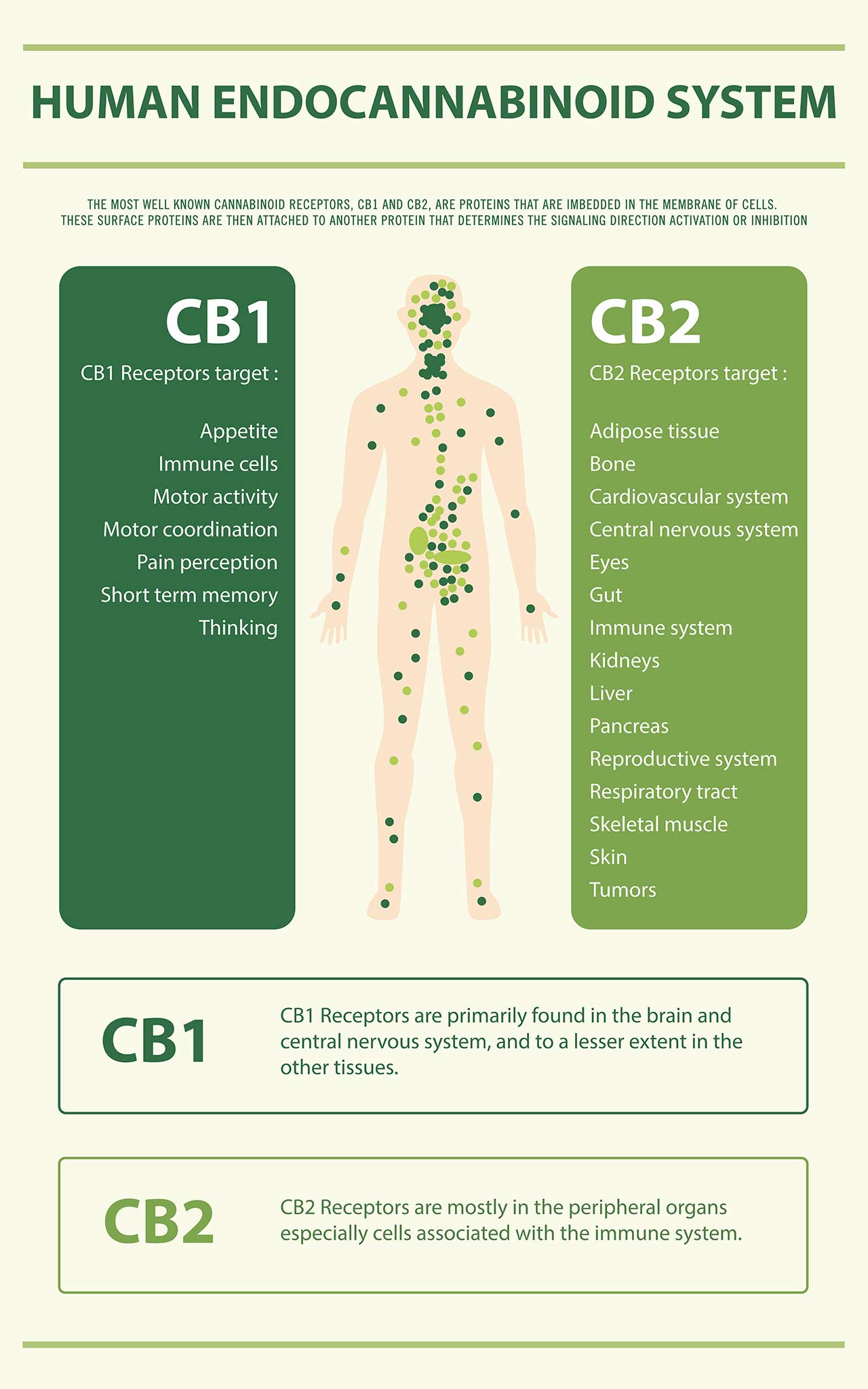Leaf411 Question of the Month: Does Cannabis Interact with Other Medication?
Medically reviewed by Katherine Golden, RN
Written by Denise Rustning
Approximately half of all Americans take at least one prescription drug every day, according to a Consumer Reports study. Many more people take non-prescription, over-the-counter painkillers, antacids and other medications.
Not surprisingly, a fair number of these people are seeking alternatives to their medications. In many cases, people are turning to cannabis—either marijuana (cannabis containing >0.3% THC, which is sold legally in dispensaries), or cannabidiol (CBD) hemp products that are sold in retail stores and online.
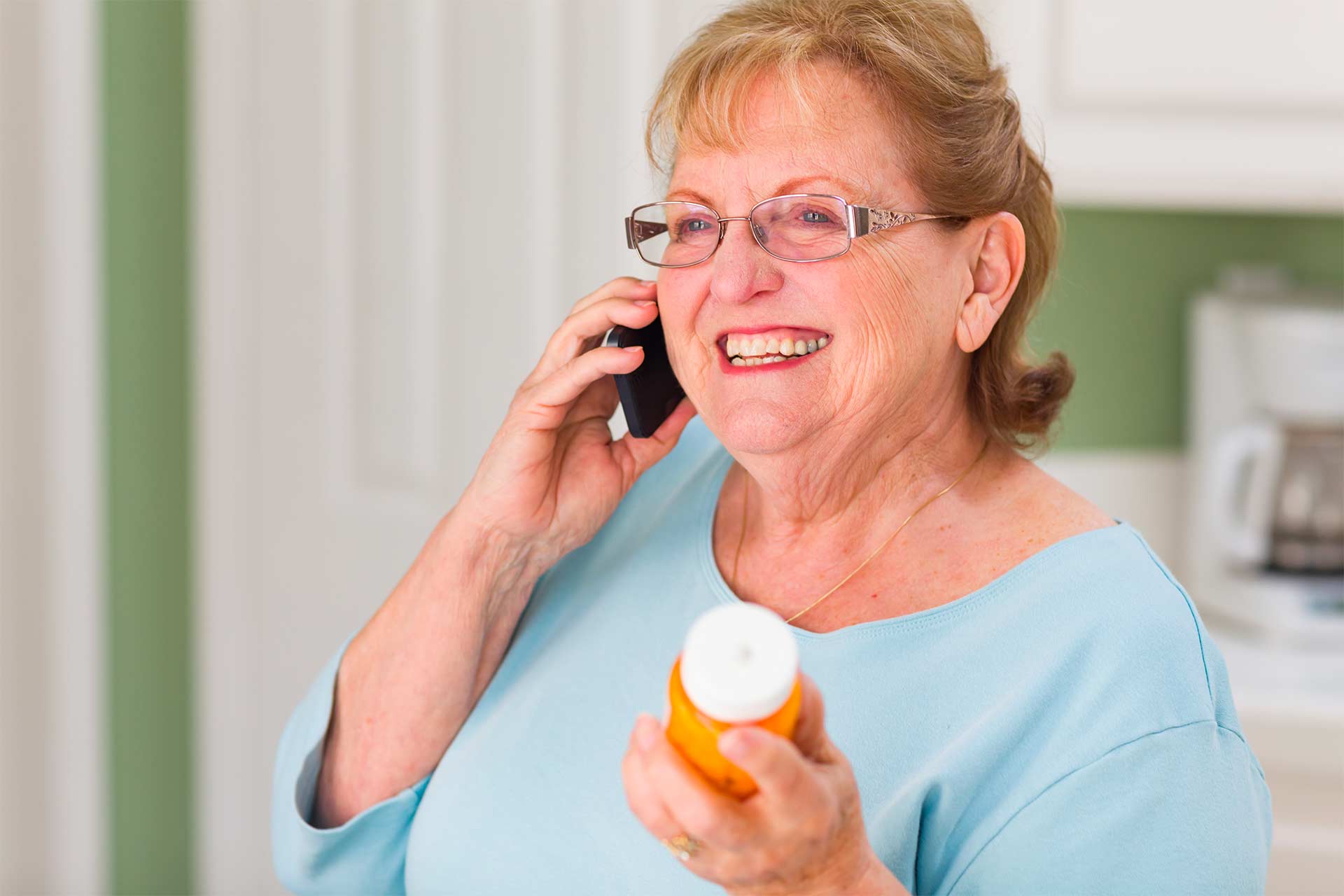
Thinking About Adding Cannabis to Your Medicine Cabinet?
We always suggest that you talk to your healthcare provider before taking any new medication. That includes CBD hemp or marijuana. Our Leaf411 cannabis-trained nurses can provide education and guidance as well as how to discuss the possibility of adding plant medicine into your regimen with your healthcare team via our free hotline: 844-LEAF411 (844-532-3411).
Also, it’s important to talk to your healthcare provider before stopping any prescription medication. It is imperative that your prescribing physician should always be the one who guides you with stopping or weaning off any pharmaceuticals.
Understanding How Cannabis Interacts with Other Medications
Have you ever wondered why you’re told to not drink grapefruit juice with certain prescription drugs?
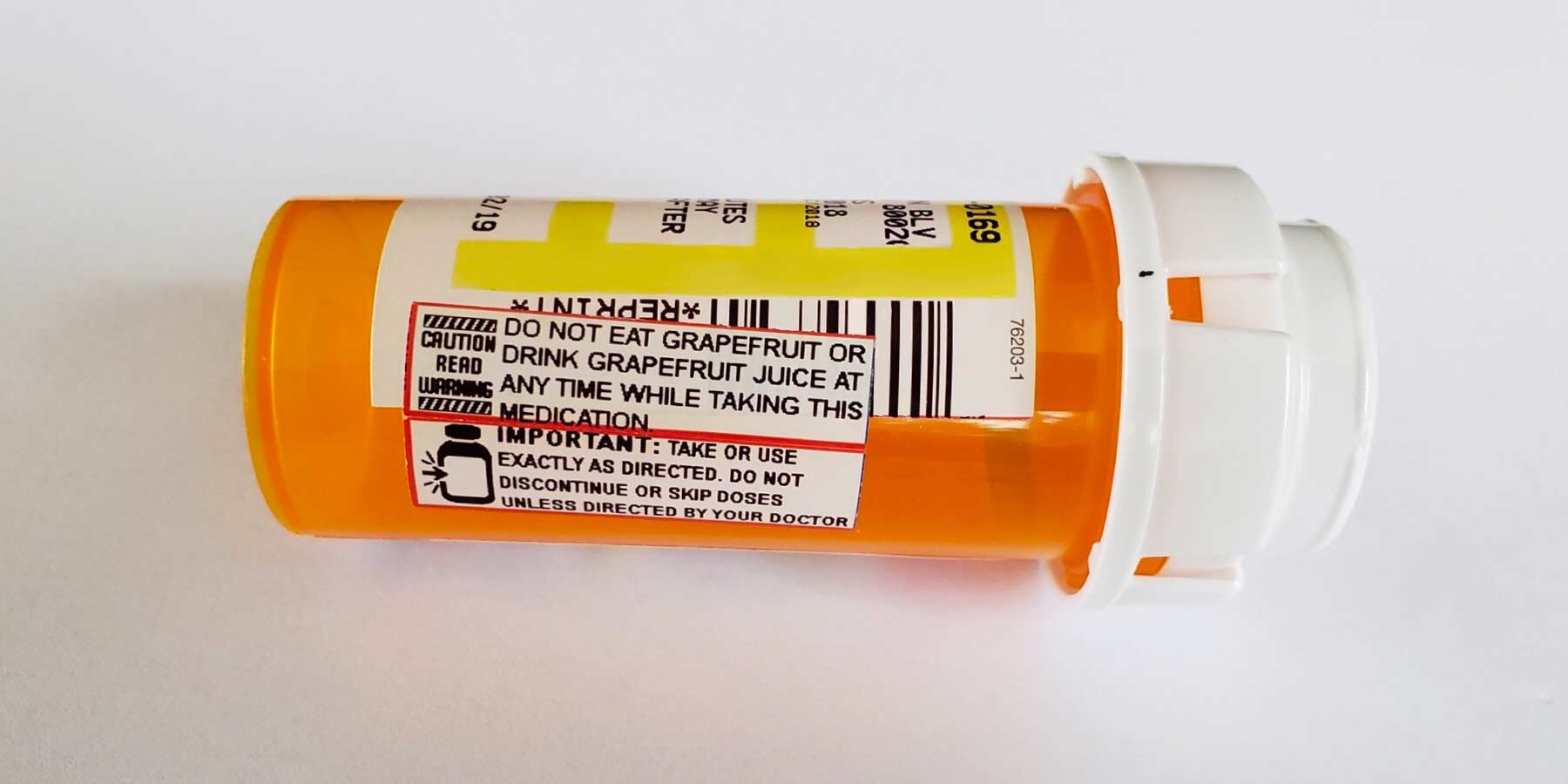
When you take medicine by mouth, it passes through your digestive system. The digestive system’s enzymes metabolize (break down) the medicine in your liver so that some of it can enter your bloodstream. The medicine dose takes into account normal digestive processes.
However, grapefruit juice affects several digestive enzymes. It blocks the enzymes’ action, and can result in too much or too little of the drug entering your bloodstream.
What does this have to do with cannabis? Well, the cannabinoids in cannabis—especially CBD—affect your digestive enzymes in a similar way that grapefruit does. In fact, scientists have found that CBD has an even stronger effect on the cytochrome P450 enzyme than grapefruit.
Cannabis, Statins, and Blood Thinners: Use Caution
An emerging area of concern is with cardiovascular medications, including statins and blood thinners. Many of these medications are metabolized by the same liver enzymes as cannabis. As a result, people who use cannabis while also taking statins or blood thinners may end up getting a higher dose of their prescription medicine than they intended, since the liver is breaking down the drug differently than normal.
Does this mean you cannot use cannabis? Not necessarily. The key is to talk with your provider and discuss any changes that need to be made to your medication dosage, frequency or timing. You might consider sharing the link to this article from the Journal of the American College of Cardiology which provides very conservative guidance for doctors to use as a screening tool who have no experience or knowledge about cannabis.
The Benefit of Starting Slow with Cannabis
Not all drugs are metabolized by the same liver enzymes. However, even if you’re taking medications that are not directly impacted by cannabis in your digestive system, it’s worth it to start with a low dose of marijuana or CBD, and to go slow. By starting slow, you can see how the addition of marijuana or CBD impacts your ongoing medications (after checking with a healthcare provider, of course!).
Also, Dr. David Gordon (Dr. Dave), founder of 4Pillars Health & Wellness, notes that people usually only need a small dose of cannabis for therapeutic benefits. This minimizes the risk of side effects. Dr. Dave explains that as an integrative physician, “We start with just a small amount, just to stimulate our own internal system. These are dosages that often don’t cause any intoxication or have any significant interaction.”
Dr. Dave is experienced at looking up potential interactions with medicinal cannabis. He’s found that most drug interactions don’t preclude someone from using cannabis, though he notes that drug doses may need to be adjusted. (You can read more from our recent interview with Dr. Dave here.)
Getting Answers to Your Cannabis Questions
Our Leaf411 hotline nurses have special training on cannabis-medication interactions. They also have access to a robust database of research.
We encourage you to call our free hotline at 844-LEAF411 (844-532-3411) with your questions about how CBD or marijuana may interact with other medications you are taking.
Leaf411 Supporter Spotlight: Dr. David Gordon, MD, 4Pillars Health & Wellness

An integrative medicine perspective on why patients turn to cannabis, the biggest medical cannabis myths, and how to talk to your doctor about cannabis as a treatment option
Medically reviewed by Katherine Golden, RN
Written by Denise Rustning
The Leaf411 cannabis nurse hotline partners with healthcare providers and cannabis industry members to expand our education outreach and increase awareness around the safe use of legal cannabis. We’re proud to periodically spotlight our supporters here.
David Gordon, MD, founder of 4Pillars Health & Wellness, was an early supporter of Leaf411, and serves as one of our Advisory Board members. Dr. Gordon, better known as “Dr. Dave,” is the creator of the 4×4 Lifestyle Plan, offering patients an alternative to conventional medical treatment. His approach addresses food, movement, relaxation, and community to help patients transform their lives.
At Leaf411, we take our ethos (kindness, professionalism and caller loyalty) very seriously. Dr. Dave fits in with our organization so perfectly, from his devotion to his profession to his loyalty to his patients. We are honored to have Dave be a member of our Advisory Board and give him this spotlight.
Leaf 411 COO Jennifer Axcell recently sat down with Dr. Dave learn more about what brings patients to cannabis, the questions and misconceptions he hears most often, and what he wishes other providers knew when it comes to advising patients on how to use cannabis.
Q: When do people typically come to you? How many other treatment options have they tried beforehand?
People have definitely already tried a lot of other options. This is true not only with cannabis, but also with an integrative approach in general.
In the cannabis space specifically, far and away chronic pain is the most common thing that we see. These are people who are still in pain despite them getting opioids or other medications. They’re still in pain despite going to physical therapy. They’re still in pain despite having surgeries and injections. They’re still suffering.
They’re definitely also tired of the risk and side effects of some of the other therapies when it comes to chronic pain. Certainly opioids—we hear about that a lot. But the risks and side effects of less toxic pain medications are underappreciated, whether it’s the ibuprofen class of meds or even Tylenol for that matter.
The biggest thing for people with chronic pain is that they’re not getting better. They’re not trying to avoid medicine. They’re really just trying to get relief that they haven’t had with other things.
If opioids were allowing people with chronic pain to feel great and be pain-free with high quality of life, these people wouldn’t be searching out cannabis.
We also see patients for lot of other conditions that standard medicines don’t treat well, be it sleep, mood disorders, or psychological symptoms. These are things that our current meds don’t do a very good job with.
Q: Is there a certain type of person who’s more likely to come to you? Is it the senior group, because they have more chronic conditions? Younger people who might be more open to cannabis? Or does it run the gamut?
The people who come to me really run the gamut, but they fall into a few categories.
A lot of people have figured out through experience that cannabis works better for them than other things. They’ve done the research and they know it’s safe. This is the average healthy person who has pain from sports injuries. It’s also the waiter or waitress or auto mechanic who comes home exhausted with pain and stiffness from work. They just want something to help their pain, help them relax and get to sleep easier. They don’t want to take a bunch of ibuprofen and Benadryl to go to sleep. They find that with a little bit of cannabis, they can relax, their pain is gone, and they fall asleep easily. This population just uses a small amount of cannabis in the evening. They know it’s more effective and safer than a lot of alternatives.
There’s also a big group of patients who have been dealing with various issues for years, and who are just sick of all the side effects and drug interactions. They want safer options. They might have been told they can’t take a variety of medications, or they’ve had side effects. These patients are looking for something they haven’t tried before because they have low quality of life. This is typically the senior population.
There’s a third patient group, the chronic pain population. The chronic pain may be related to an injury from a car accident or disc injury, or it could be non-injury related. Some patients have central pain issues like fibromyalgia, irritable bowel, irritable bowel syndrome, chronic pelvic pain, these kind of nebulous pain syndromes. That’s where you get the patient who says, “I haven’t had a good day in 25 years no matter how many meds I’ve taken.”
Q: What are the top three questions about cannabis that you get from patients?
These days, one of the top patient questions is about the different chemicals in cannabis, specifically THC and CBD. What is CBD? What is THC? What’s the difference?
Another common question is how best to administer cannabis, whether you’re talking about inhaling or eating or topical. People always want to know what’s the best.
Also, for patients who are new to cannabis, their questions involve safety, side effects, and interactions with other medications.
Q: What are some of the biggest misconceptions you hear from people, when it comes to using cannabis for health purposes?
New users often assume that using cannabis means that they’re going to be so high that they can’t function. That’s far and away the biggest misconception. I might explain to them that we’re going to use certain cannabis compounds that don’t cause any intoxication. Even if we’re using THC, the one compound that can cause intoxication, we might be starting it at a dose that they’ll barely notice or not notice it at all.
Also, a lot of the cannabis propaganda that people have heard over time is just wrong. The perfect example is when someone asks, “Is cannabis going to cause me to lose my brain cells?” Or they are worried it will cause early-onset Alzheimer’s. No, actually, the science shows that cannabis is probably going to protect your brain. We know that both the cannabis THC and CBD compounds protect brain cells. And there’s good evidence suggesting that they may reduce the risk of dementia.
Another misconception I hear is that cannabis is super-addictive. People just assume it’s a highly dangerous, addictive drug like heroin or cocaine, based on the propaganda they’ve heard. I share the actual information that’s out there in the research showing this propaganda is not true.
People also tell me, “My doctor told me there’s no research. There’s no science showing cannabis works.” (Dr. Dave responds to this misconception below.)
There are a lot of myths about cannabis—the list goes on. But those are some of the main ones that people come in with preconceptions about.
Q: At Leaf411, one way we’re answering that concern about research is with our online Leaf Library. How do you answer questions about research, beyond saying “trust me”?
My response varies between patients based on how they learn and what they want to know. We have different levels of research. You know, we have research that’s done in the lab that shows how and why cannabis works. And then we have research in animals showing its benefit. We also have research in humans, but the research in humans often isn’t as robust as we have for other medications because of the restrictions.
But I also remind people that most of what happens in a regular conventional medical office is also not supported by gold standard research using large-scale double-blind trials. Most conventional providers’ practice is based observational studies or recommendations, the exact same kind of research we have for cannabis, as well.
Evidence-based medicine is not just picking one study and saying, “Here’s the evidence. This is what we do.” Evidence-based medicine is combining the best research and science we have with our patients’ experiences, and with physicians’ experiences. And using those three aspects to make decisions that are best for a given patient. That is true evidence-based medicine.
Q: From the patient perspective, when is the best time for someone to talk to a cannabis physician?
I am a little biased, but I think early on is best. In a perfect world, everybody would get guidance, even people who are knowledgeable about cannabis.
When I see a patient who tells me they’ve used cannabis for 25 years, there’s still information that I can provide to really optimize their treatment.
When we’re talking about the person who is new to cannabis, I think early is best, ideally before they use it or within the first month.
My biggest concern with a new cannabis patient is that they’ll have a negative experience early on due to the product they tried or using too much.
It’s not dangerous but they felt uncomfortable. That creates a negative association. We know in all treatments, someone’s initial experiences play a huge role. We want to avoid negative experiences early on, because that makes future treatment more difficult.
I think all people need some education early on how to use appropriate dosing and appropriate products to minimize negative experiences. And a lot of that’s just starting really low. I don’t think the industry facilitates that in the way they package and label products, and I don’t think budtenders facilitate that. Most people working in dispensaries are cannabis users, and probably have higher tolerance than someone who is new to cannabis. They may not understand low dose concepts like building up the dose slowly.
I don’t think someone necessarily has to see a doctor, but they should get guidance on the concept of starting low. This could come from an educational resource like Leaf411.
Obviously, seeing a cannabis doctor can increase the likelihood that the first thing the person tries will be effective. Talking to any knowledgeable healthcare provider makes it more likely that someone will find the most effective dose or product sooner.
Q: How do you guide patients to talk to their primary care doctor, knowing that there is resistance and lack of knowledge among some providers?
I recommend that patients start by sharing their personal feelings and goals.
Don’t just say, “I’m using cannabis, deal with it.”
Instead, maybe say, “Hey, I’ve been really struggling with this. You know that we’ve tried many things and I haven’t been getting optimal results. I’ve tried this new thing. It’s really helping me. I’d really like to stick with this because I’m feeling better.”
If the doctor hears the patient articulate that they’re doing well and they’re achieving their goals, but they’re not willing to support that—I mean, I usually tell patients that’s the time you need to think about getting a new doctor.
If a doctor doesn’t know something and says, “Okay, I’d love to learn more. How can I support you?” that’s okay. They don’t need to be a cannabis expert.
I wish that every doctor understood the low dose concept. If a patient said, “I want to try cannabis,” the doctor’s response would be, “I don’t know anything. But all I know is that you start with one or two milligrams and go up every few days.” If every doctor just knew that, that would be outstanding.
Q: Many people in the cannabis space have a story. What’s yours?
My story is not so much a personal story. For me, it’s really just seeing what worked with patients and what didn’t work.
I always wanted to be a doctor and enjoyed the sciences, and started on a pretty straight path going to medical school. I had no exposure to integrative medicine or anything beyond standard medicine throughout my training.
I started my own practice right out of residency, a general internal medicine, primary care practice. Paying attention to patients and how they were doing, I realized what I was taught didn’t work very well. I was doling out medicines left and right, and yet people were not getting better. Even if their numbers got better, I would see them keep coming in with side effects and new issues.
Within the first year or two of practice, I decided that I needed better tools. I started learning more about nutrition and root causes of health issues, and expanded into integrative practice where I had a bigger toolbox. I partnered with patients, spending more time with them to find out what their triggers were. Then, I incorporated new tools, using other practitioners, chiropractors, psychologists, physical therapists, and acupuncturists. I also taught myself more about nutrition and incorporated that piece as well. Patients really got better using those modalities.
Once cannabis was legalized in Colorado, I immediately had patients coming to me and saying, “Oh, I’ve already been using cannabis for my pain,” or “I’ve been using cannabis for sleep,” or for other conditions. Patients asked, “Will you authorize my medical card?” These were patients I knew and trusted, and so I signed off on that.
After hearing similar stories from many patients, I thought I should try to learn about cannabis beyond just signing off on it. When I looked into things, I was blown away by how much information was already out there about the endocannabinoid system and cannabis. At the time, there were a few decades of research showing what cannabis does, why it works, and how people were benefiting from it.
I saw this firsthand in my practice, as well. When patients were struggling, I looked at using cannabis as a bridge to help them get better so we could implement other dietary and lifestyle measures. Cannabis was just one part of my toolbox.
My story has really been focused on what’s best for the patient. That’s what led me to general integrative medicine, and to cannabis specifically.
This interview has been edited for length and clarity.
For More Information
You can learn more about Dr. Dave and 4Pillars Health & Wellness here. Dr. Dave provides in-person, phone, and video consults for people seeking guidance and education on cannabis as well as other integrative health practices to improve overall health. He also offers office appointments for Colorado residents seeking a medical marijuana card.
The Leaf411 cannabis nurse hotline is proud to have supporters like Dr. Dave. Our nurse team depends on our medical advisors to take our callers to the next level of care that is outside our scope of practice and Dr. Dave can do just that. He takes in-person, phone, and video consultations from all over the country. We are proud to list his practice as a resource for our callers.
We recognize that not everyone may have the resources to visit a cannabis doctor. That’s a big reason why we set up our hotline as a free service available to anyone, anywhere, regardless of their insurance coverage or ability to pay.
Do you have questions about using cannabis for a health concern?
Would you like to learn more about the low dose concept?
Call 844-LEAF411 (844-532-3411) for answers from our cannabis-trained registered nurses.
CBD Hemp 101: Full Spectrum, Broad Spectrum, Distillate and Isolate
Medically reviewed by Katherine Golden, RN
Written by Denise Rustning
Are you confused by all the different types of CBD? Don’t worry, we’ve all been there before!
All cannabinol (CBD) starts off as a compound in either hemp or cannabis plants. The plants undergo various processes to extract CBD, resulting in a range of CBD products. We break down the main types of CBD below, along with the pros and cons of each type.
Full Spectrum CBD: Wide-Ranging Hemp Benefits
Full spectrum CBD oil contains most of the of the hemp plant compounds, including terpenes, flavonoids, essential fatty acids, CBD, cannabigerol (CBG), and trace amounts of tetrahydrocannabinol (THC), staying below the 0.3% federal limit for CBD hemp products. The plant compounds work together to create a synergistic entourage effect that can boost the benefits of the CBD hemp plant. Full spectrum CBD oil is often a green color, reflecting the presence of those compounds. The color and flavor can even change between product batches due to variations in the plants.
- Pro: Full spectrum CBD provides all the power of the hemp plant, available in a variety of product types from topicals, tinctures and edibles to vape concentrates, as well as crumble that can be dabbed (smoked with a special rig). It’s less processed than other CBD concentrate types, as well.
- Con: Full spectrum CBD contains trace amounts of THC (under 0.3%). While it’s not enough THC to be intoxicating, the verdict is out on whether it’s enough to trigger a positive drug test result. Also, because full spectrum CBD retains the original plant compounds, it has a natural flavor that some people may find off-putting. Many manufacturers add fruit or mint flavoring to their full spectrum products to balance out the flavor.
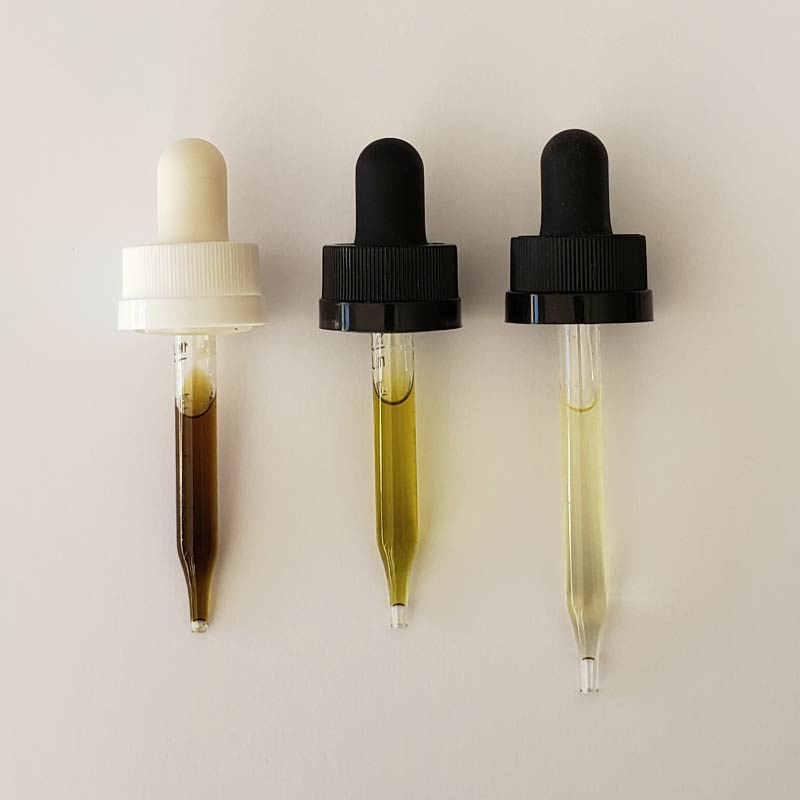
Broad Spectrum CBD: A THC-Free Option Loaded with Hemp Power
Broad spectrum CBD is similar to full spectrum CBD, except that the product goes through additional refinement to remove all THC. It’s important to note that the terms “full spectrum” and “broad spectrum” sometimes get confused, even by product manufacturers and marketers. Furthermore, past research has shown that product labeling can sometimes be inaccurate. Be sure to check the manufacturer’s test results on the product Certificate of Analysis (COA) to confirm this!
- Pro: Broad spectrum CBD maintains most of the plant benefits while eliminating THC, and can be used in the same ways that full spectrum is used. This may be an appealing option for people who want or need to avoid THC due to workplace drug testing; however, given the confusion around labeling, a safer option would be CBD isolate, which we discuss below.
- Con: Removing trace amounts of THC requires additional refinement which also pulls with it additional minor cannabinoids and lessens the CBD content in the process, moving CBD further away from its full plant form. Also, given the concerns around inaccurate labeling and testing, broad spectrum CBD is not the ideal choice for athletes and professionals who are subject to drug testing.
Distillate CBD: A Powerful Hemp Concentrate
Distillate CBD is a concentrate containing between 80% – 90% CBD. In order to make distillate CBD, additional steps take place to filter out impurities and remove most of the non-cannabinoid compounds, including terpenes, flavonoids and essential fatty acids. This process results in a product with a honey-like consistency that is odorless and tasteless.
- Pro: Distillate CBD retains the plant cannabinoids, including minor cannabinoids and THC (less than 0.3%). Distillate is often used in vape products, edibles and topical products given its high concentration, purity and lack of odor or taste. This results in a more consistent product.
- Con: Distillate CBD undergoes additional post-processing extraction. Also, it provides a narrower range of plant-based benefits when compared to full spectrum products.
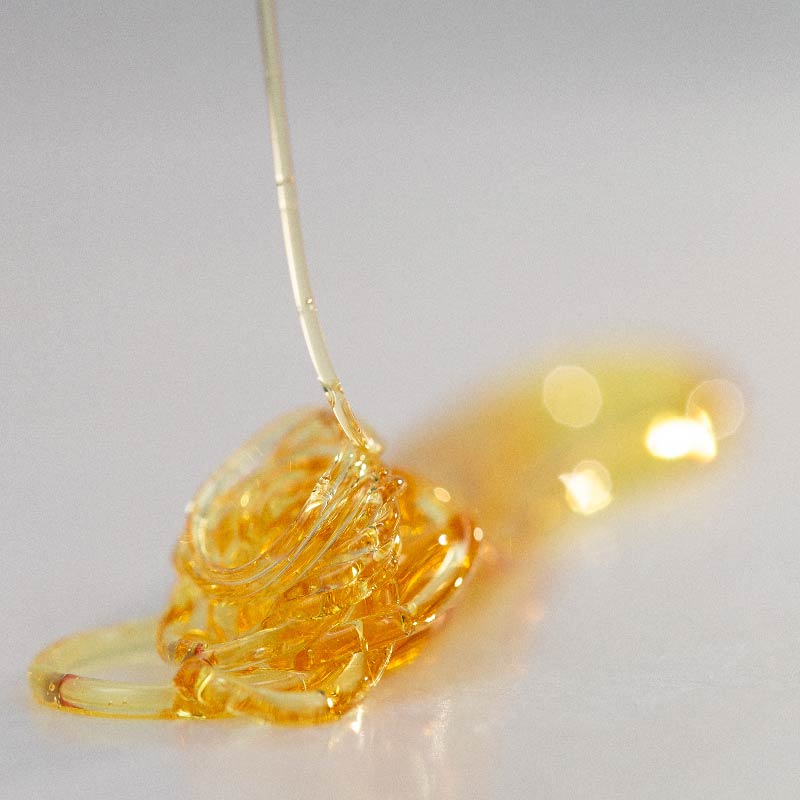
Isolate CBD: Pure Cannabidiol
Isolate CBD is the purest form of CBD available, consisting of approximately 99% CBD in white powder form. Unlike distillate, CBD isolate doesn’t contain any other cannabinoids or plant compounds. This makes it a favorite among people, such as professional athletes, who cannot risk ingesting even trace amounts of THC. Products made with isolate CBD are often labeled as “No THC,” though you’d want to check the Certificate of Analysis (COA) test results to ensure this is true.
Our Leaf411 nurses recommend using isolate CBD consumer products that are designed to provide consistent, pre-dosed administration, and which are manufactured by reputable companies, such as our member partners. While isolate CBD is also sold as bulk powder, we have concerns about product quality and dosing.
- Pro: Isolate CBD does not contain any THC, making it the safest bet for people who cannot risk positive drug tests. Manufacturers use isolate CBD that they mix into their drink products, foods (edibles), topical products or tinctures, while isolate CBD wax can be dabbed but should be used with caution.
- Con: The drawbacks are similar to those we discussed with distillate CBD. Isolate CBD’s purity means that many other beneficial plant compounds have been stripped out.
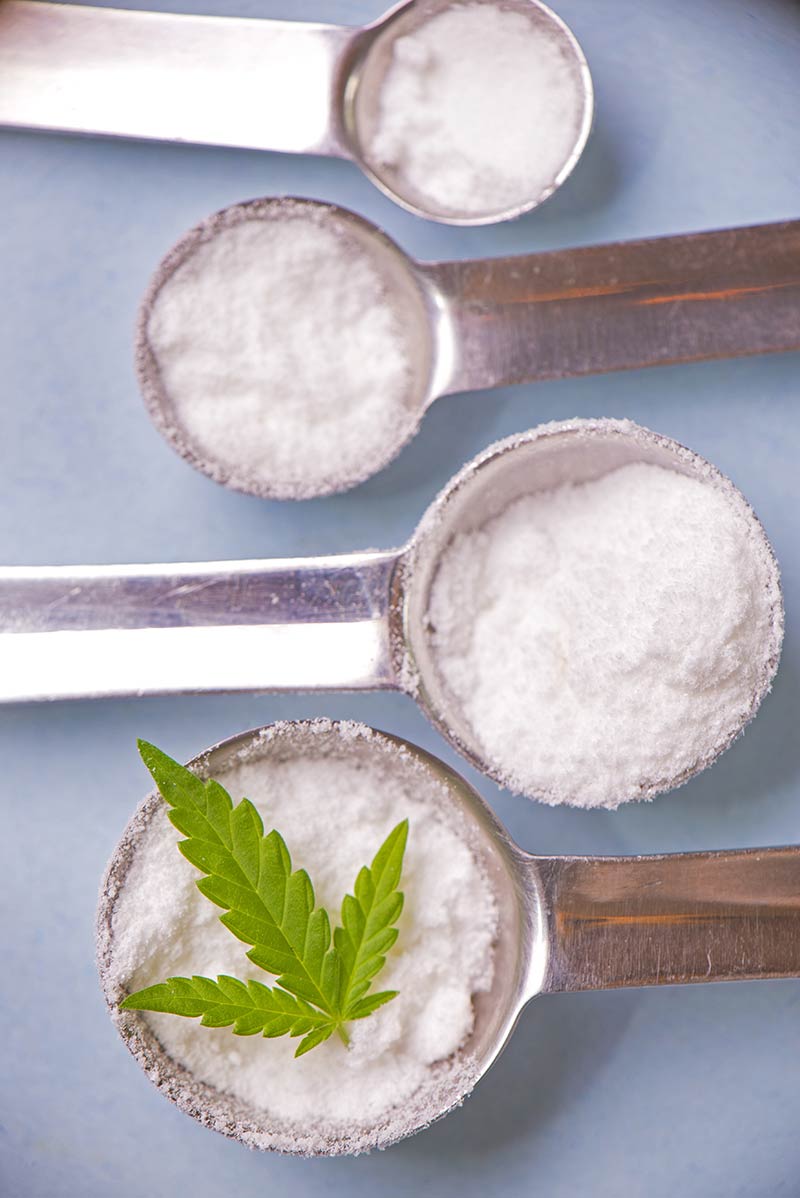
How to Choose the Best Type of CBD
We wish there was an easy cheat sheet or quiz for finding the best type of CBD. Beyond a few basic considerations, though, it can be a process of trial and error.
We encourage you to continue your journey into finding reliable, accurate CBD information from reputable sources. One of our favorite sources is ProjectCBD. You can find more CBD 101 information that we stand behind at this link.
Our Leaf411 cannabis-trained nurses are happy to provide guidance on the different types of CBD and how they might help address your specific needs. Call our free, anonymous hotline at 844-LEAF411 (844-532-3411) for medically-sound answers to your cannabis and hemp questions.
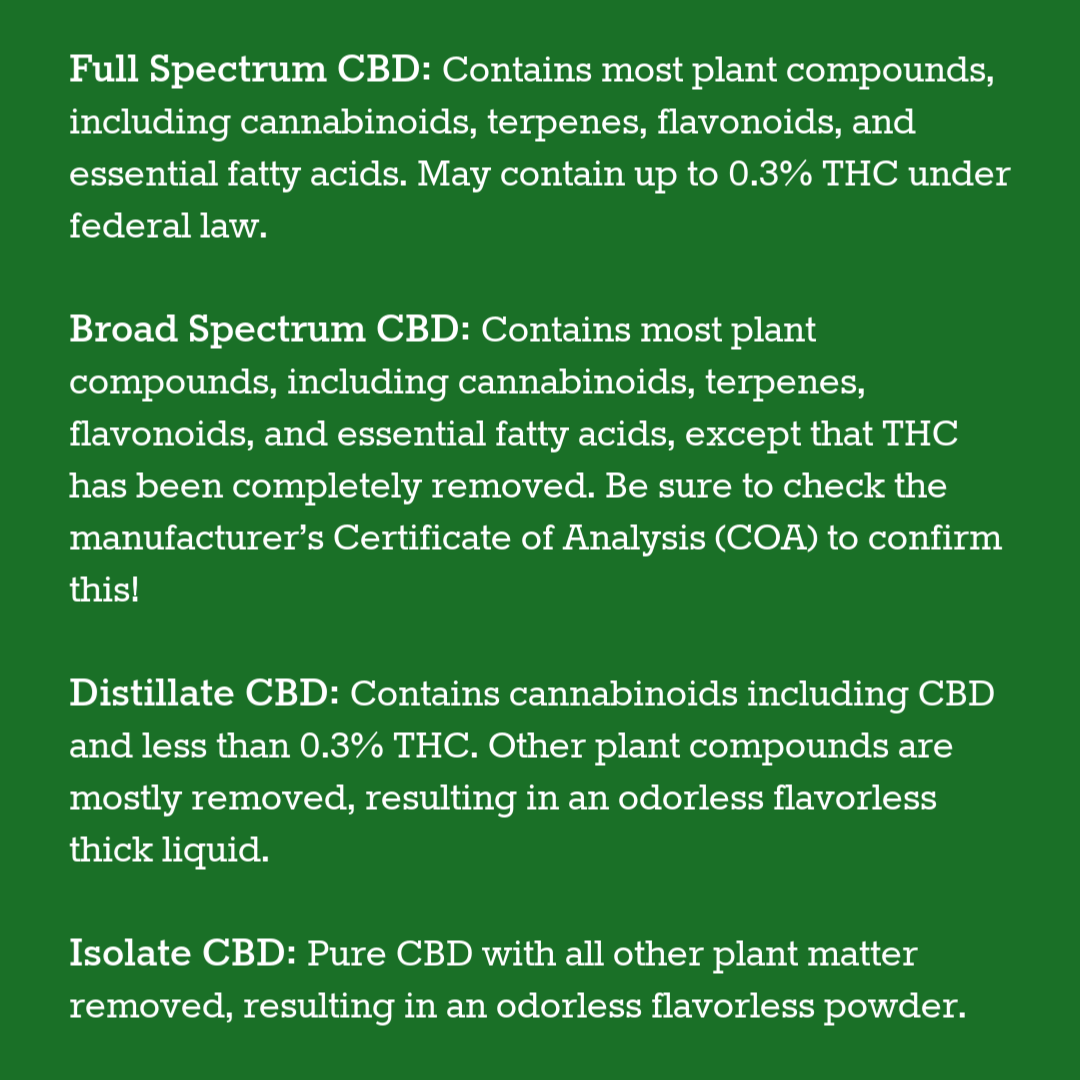
Your New Year’s Resolutions – And How Cannabis Might Help
Medically reviewed by Katherine Golden, RN
Written by Denise Rustning
Look at the top New Year’s resolutions and you probably won’t be surprised. Most goals are focused on healthy choices—eating better, sleeping more, exercising. At their core, our resolutions are about finding better balance in our lives.
You might be surprised to learn that legal cannabis and hemp CBD can support your goals for better balance. The key is to use these products in moderation together with other positive lifestyle changes.

You Have an Endocannabinoid System – And It’s Made for Balance!
Your body already has a built-in system for maintaining internal balance (also called homeostasis)—the endocannabinoid system (ECS). This system exists in humans and most animals. It plays an important role in regulating metabolism, sleep, mood, and immunity, along with other functions.
Your body’s ECS contains two types of cannabinoid (CB) receptors: CB1 and CB2.
- CB1 receptors are found in your central nervous system—primarily your brain and spine. These receptors play a role in memory, behavior, appetite, motor control, and perception of pain.
- CB2 receptors exist throughout the body, helping to control inflammation and immune response.
Your body makes endocannabinoids which bind to the CB1 and CB2 receptors, signaling when your body’s system needs to take action to maintain or restore internal balance.
You can also use products which contain cannabinoids that interact with these same CB1 and CB2 receptors to help bring balance.
There are many different cannabinoids. These include cannabidiol, better known as CBD, and tetrahydrocannabinol, or THC. Both are present in cannabis. THC provides the “high” that many people associate with cannabis, while CBD doesn’t have any Intoxicating effects.
When thinking about the connection between your ECS and cannabis, it’s helpful to look at how you already use medicines to help your body. For example, your body generates pain-killing endorphins in response to pain, but you can also take ibuprofen to reduce pain and inflammation. With cannabis, the difference is that endocannabinoids (produced by your body) and cannabinoids (produced by the cannabis plant) are very similar to one another, which minimizes unwanted side effects.
Kickstarting Your Resolutions with a Good Night’s Sleep
Better sleep may not be on your list of New Year’s resolutions. However, being well-rested will definitely help you achieve your goals!

While many of us get the recommended amount of sleep each night, the quality of that sleep isn’t great for a lot of folks. The National Sleep Foundation reports that over a third of Americans report low-quality sleep.
Many people are discovering that cannabis and CBD hemp products help them relax, fall asleep, and wake up more well-rested. However, finding a product that works for you may take time, and the options can feel overwhelming!
If you are interested in using flower (the plant buds), start with indica-dominant or hybrid cannabis strains that are known to promote good sleep. These strains also contain beneficial plant compounds called terpenes that help with sleep as well.
Cannabis edibles designed for sleep are also an appealing option for many people. While edibles take longer to kick in than smoking or vaping, their effects also last longer. This means that if you wake up in the middle of the night to use the restroom, you might feel unexpectedly high. Edibles also have a reputation for causing brain fog in some people when they wake up, though this isn’t the case for everyone. Timing is key when consuming your product. Our nurses at Leaf411 can help guide you in the right direction for the best edible dosage and timing.
Also, you’ll want to check the label on any edibles or tinctures for the full list of ingredients. Manufacturers sometimes add melatonin, valerian or other herbs to boost their product’s sleep-inducing power. It’s up to you to decide whether those added ingredients are needed or not.
Our founding members at 1906 have put exhaustive research and refinement into their formulation, Midnight, because sleep issues are one of the most prevalent health problems Americans face. Midnight’s key ingredient, corydalis, has been used for millennia, and works in several crucial ways which maybe why it’s 1906’s best-selling product!
Cannabis plays a useful role in improving sleep quality, though too much THC and CBD can be counterproductive, increasing alertness or anxiety, or leaving you feeling groggy the following day. If you experience any of these symptoms, you may want to look for a product with lower THC and CBD concentrations or try CBD hemp products instead.
Some people prefer products that don’t contain THC, either due to employment-related concerns with drug testing, anxiety or personal preference. CBD isolate products provide a great alternative—but make sure you ask for a COA (Certificate of Analysis) prior to purchasing to ensure it has zero THC.
It’s important to note that CBD is not a sedative. It will not knock you out like a prescription sleep medication. Instead, CBD’s power comes from its potential to reduce anxiety and pain while also helping to regulate sleep. Hemp-based products are widely available online and in retail stores, eliminating the need to visit a dispensary (though many dispensaries may carry CBD products as well). Remember to look for reputable manufacturers who provide COAs to back up their product quality.
Our founding member Altus’s mission is to empower you to make the most educated and personal choice when selecting a cannabis product. They created helpful Pillars to categorize their products based on users’ needs. Their Ritual products are low-dose thc or non-intoxicating products designed for daily lifestyle needs. That includes maintaining endocannabinoid system balance, managing minor issues, and helping to get better rest.
If you’ve ever talked to our Leaf411 nurses, you’ll know that cannabis is only part of the picture when it comes to better sleep. We also encourage you to look at underlying issues and bedtime habits that may be keeping you up at night. Even the strongest indica can only do so much, if your nighttime routine includes scrolling through drama-filled threads on Twitter, Facebook or Instagram
Our Leaf411 hotline nurses are happy to discuss the pros and cons of different cannabis sleep products with you. Call our free, anonymous hotline at 844-LEAF411 (844-532-3411) for guidance specific to your needs.
CBD-Powered Workout Recovery
Exercise tops many peoples’ lists of resolutions. Sadly, it’s a resolution that many people quickly abandon for well-known reasons: the goal isn’t specific enough; it’s not stated positively; or it doesn’t answer the “why”—that is, why the goal is important to you. Many articles provide helpful tips for sticking with your exercise goals (like habit tracking or setting specific goals or identifying why you’re doing it).
We have an additional suggestion for keeping your exercise resolutions: CBD. Waking up early on cold, dark winter mornings is hard enough without fighting against soreness from the previous days’ workout. Many professional athletes use CBD products for pain and post-game recovery. You don’t need to be a pro player to tap into the benefits of CBD, though!
Our founding members over at Arcanum have been dedicated to producing products that complement active lifestyles. They were the first company to sponsor a professional sports team in the United States and know a thing or two about recovery!
Arcanum Edge’s Sarco Freeze topical cooling gel comes in two different strengths, and combines CBD with arnica, menthol and other herbs to provide immediate post-workout relief while also soothing sore muscles. Sarco Freeze received a positive review by the Athletes for Care Tastemakers program, which is made up of professional athletes.
They also offer Sarco Skin, the first CBD and menthol-infused kinesiology tape and The Coil family of tinctures which are terpene-infused for more benefits and bioavailability.
Arcanum Edge’s best-selling product is The Quill transdermal gel delivery pen. The Quill provides patented transdermal delivery of a precise microdose of full spectrum extract and terpenes. Leaf411 is proud to support Arcanum Edge as a trusted source for performance-driven CBD products. Arcanum Edge products are third-party tested with their COAs available online. They also provide a 30-day, 100% money back guarantee.
Out of Balance: Too Much Cannabis?
Cannabis is a tool, not a magic cure-all. While we enthusiastically support the benefits that this plant provides, we also caution that you can overdo it with any medicine, including cannabis. If you would like help cutting down on your marijuana use or switching to different types of products (for example, switching from smokable flower to edibles), our Leaf411 cannabis-trained nurses can help by providing non-judgmental, balanced guidance. We also provide resources at our online library.
Are you interested in exploring cannabis or hemp CBD’s health benefits in 2020, but not sure where to start? Our nurses can help! Call our free, anonymous hotline at 844-LEAF411 (844-532-3411).
The Leaf411 cannabis nurse hotline provides free, anonymous education and directional support to the general public about the safe use of legal cannabis. We partner with select business members who meet our rigorous standards to extend our education and outreach efforts.

